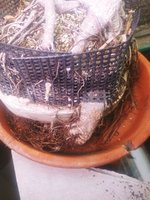JBP_85
Yamadori
Hi Everyone,
I've been looking around at options for repotting my seedlings/tiny trees (Tridents, Dawn Redwood, & Bald Cypress) in the spring. I have a plan for RoR for one or two of my Tridents and more traditional informal upright styling for my other trees. It has been suggested that I get them into larger pots (possibly cut down 10 - 15 gal nursery pots) in order to establish a good radial root systems. My question is what route should I go here? It seems like the Anderson Flats are popular here but I also read about people using collanders and grow bags as well. Is there a flow chart somewhere I can use to help make this decision lol? Are there advantages to one over the other? I'd be interested to hear your experiences/preferences. I'm sure I'll have questions about what substrate works well for each option immediately after this so fell free to chime in there as well. Thanks as always!
I've been looking around at options for repotting my seedlings/tiny trees (Tridents, Dawn Redwood, & Bald Cypress) in the spring. I have a plan for RoR for one or two of my Tridents and more traditional informal upright styling for my other trees. It has been suggested that I get them into larger pots (possibly cut down 10 - 15 gal nursery pots) in order to establish a good radial root systems. My question is what route should I go here? It seems like the Anderson Flats are popular here but I also read about people using collanders and grow bags as well. Is there a flow chart somewhere I can use to help make this decision lol? Are there advantages to one over the other? I'd be interested to hear your experiences/preferences. I'm sure I'll have questions about what substrate works well for each option immediately after this so fell free to chime in there as well. Thanks as always!

